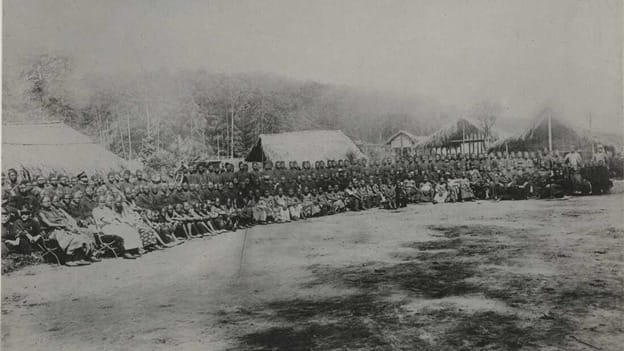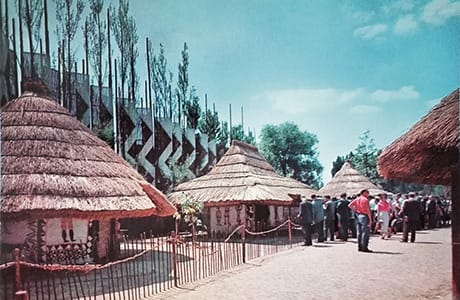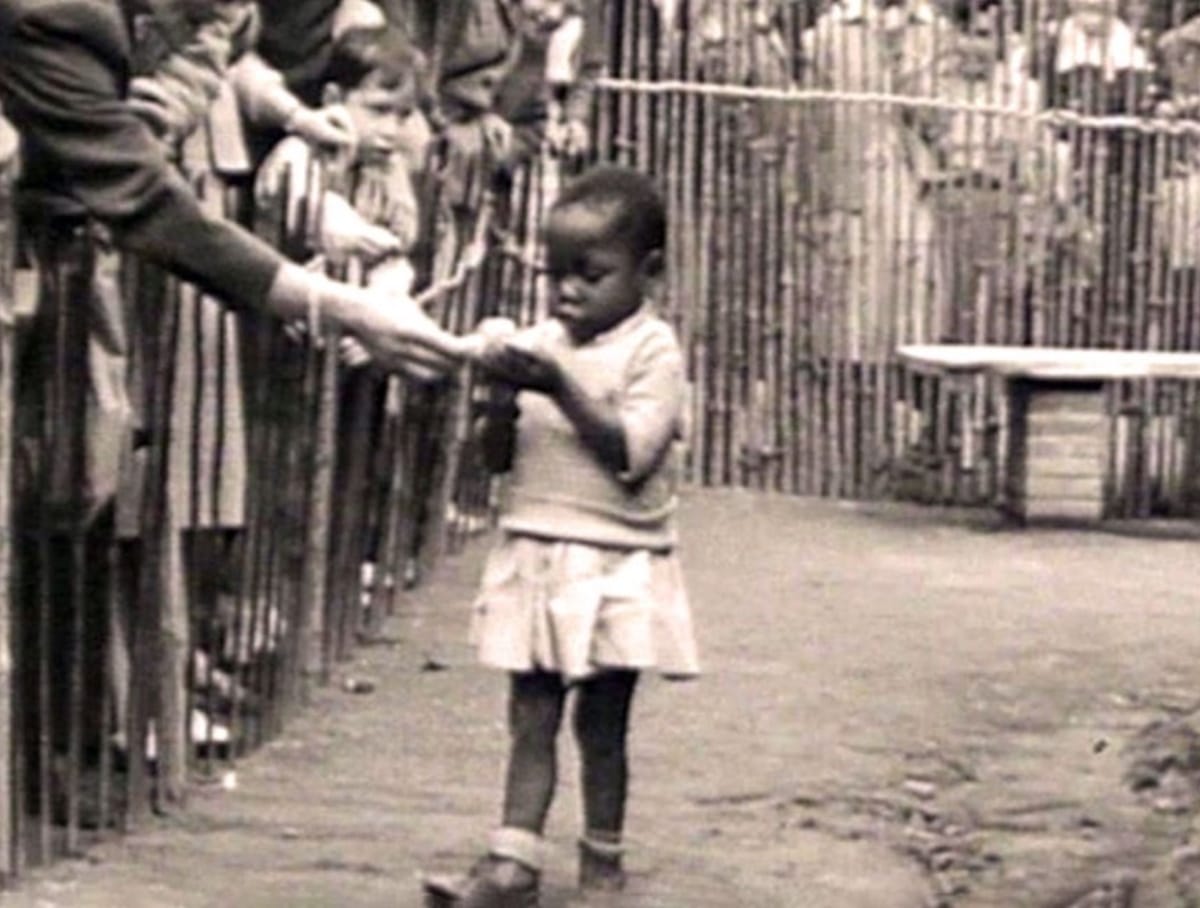On the Internet you can find photographs that, as indicated, depict teenagers from African countries who became the object of idle interest of white people in the middle of the 20th century. We checked whether such entertainment really existed in a European country.
Major photographs circulating on the Internet along with captions about "human zoo", two. One depicts the likeness of an enclosure, from behind the fence of which Europeans are looking at an African girl. In another picture, a small African boy sits in a cage, surrounded by two white girls, in some cases TBCthat the African became a “toy” bought by their father. According to the captions, the photographs were taken in Belgium either in 1955 or 1958. The message of many publications is the following: Europeans were racists relatively recently, and now they teach others tolerance.
Photos with similar captions were posted by information and entertainment resources (“Russian newspaper", "Peekaboo"), as well as users of social networks and blogging platforms (Facebook, "Zen", "VKontakte"). In 2023, the pictures became widespread in Russian-language Telegram channels - they were published, in particular, by “Yakov Kedmi"(1.9 million views at the time of writing this analysis), "The world today with "Yuri Podolyak"" (1,600,000), "Russia now" (411,000) and "Solovyov» (324,000).

Even during the era of the Great Geographical Discoveries, European travelers often brought with them from distant lands representatives of the indigenous population, who were then put on public display. However, whole phenomenon so-called "human zoos" became closer to the end of the 19th century, during second wave of global imperialism. Not the least role in this was played by racial theories that grew out of ideas social Darwinism: in Europe and the USA it has become fashionable to show people from Asia and Africa in the most natural and primitive savage form, often next to monkeys, to show the evolutionary superiority of the white race. Sometimes the display of "natives" was part of the so-called colonial exhibitions, which presented the economic achievements of the colonies. Human zoos could be visited in Antwerp, Barcelona, Hamburg, London, Milan, New York and Warsaw, a city that was then part of the Russian Empire.
Among the states that had overseas territories in the second half of the 19th century was Belgium. The main driving factor in their development and use was the king Leopold II - a supporter of the ideas of colonialism, who from 1885 to 1908 was actually the sole owner of the Congo Free State, which he founded. Over the years, the population of the region, abandoned to growing rubber and mining ivory, according to experts' estimates, decreased by half - from 20 to 10 million people. Especially for the 1897 World Exhibition, which was held in Brussels, Leopold ordered the recreation of a fenced-in, but open to visitors, building on his country estate. Congolese village, where he brought 267 men, women and children. Some of them died from pneumonia and influenza, others fell ill due to eating sweets thrown by the crowd.

In 1908, a year before his death, Leopold sold territory of the Congo Free State to the Belgian government, and colonial life there continued, but with less catastrophic consequences.
By the mid-20th century, Africa was still largely colonial, and the Belgian Congo was no exception. When Brussels again gained the right to host in 1958 World's Fair, the local authorities seemed to have decided to remember the experience of their predecessors and set up another village called Kongorama. Its inhabitants, unlike the Congolese at the beginning of the century, arrived in Belgium voluntarily - a total of 598 people (273 men, 128 women and 197 children). Their main occupation was the demonstration of folk crafts.

However, everything did not go as the Africans imagined. According to According to Zana Etambala, a historian at Belgium's Royal Museum of Central Africa, instead of a cultural exchange, the guests found themselves behind a bamboo fence, and some of the Europeans watching them made monkey noises to attract attention. “They threw bananas and peanuts and the Congolese protested against it. They wanted to be respected and not treated like zoo animals,” says Etambala, who grew up in Belgium and the Congo. In total, the Congolese were supposed to spend six months in the European country, but after about three months their patience ran out and the inhabitants of the colony left. The exhibition continued without the ethno-village.
In 2018, to this not the most honorable page in the history of the country appealed Belgian television. In the report, in addition to video footage, they showed the same photograph taken at the exhibition, in which the crowd was looking at an African girl. It is noteworthy that in general, that World Exhibition, according to historians, accelerated the decolonization of Africa: many future leaders of national movements on the continent, such as the Congolese Patrice Lumumba, discovered another world, got to know each other and discussed the future of their territories. For one year 1960 on a map of Africa appeared 17 new sovereign states.
However, it was only in 2020 that the Belgian King Philip expressed regret about the “exploitation and domination” colonial policies his country had pursued for decades. “This regime was an unequal regime, unjustified, marked by paternalism, discrimination and racism,” the monarch said. However, as of 2023, no official apology has been made.
As for the second photo, with the boy in the cage, his story is different. In the 20th century, Belgian children could not buy another child - slavery was first prohibited in the country Constitution 1831, then by joining General Act to combat the slave trade. The photo was clearly not taken in a human zoo - in the background, dresses, presumably those of the girls themselves, are drying, that is, everything is happening on private property. In addition, the vegetation in the background looks exotic, unlike the flora of Belgium.
The photo can be found on website Center for Historical Research and Documentation on War and Modern Society at the State Archives of Belgium in the album entitled “Collection of Monsieur van de Meersch. Belgian Congo (1950–1960)". In fact, nothing more about this photo to specialists unknown - neither the exact year nor the location, only that it was taken from the album of a family who lived in what is now the Democratic Republic of the Congo more than half a century ago. In 2020 photo used for the cover of a photo album entitled “White and Black in Black and White”, dedicated to the Belgian Congo, but even more often her exhibit on social networks with incorrect or unsubstantiated captions such as stories about a human zoo or generally illustrating publications about the French colonies in North Africa. Found on the web and colorized photo option. It has nothing to do with the 1958 exhibition in Brussels.
Nevertheless, the first photograph and the caption under it generally adequately describe the situation that arose in 1958 at the World Exhibition in Brussels. Indeed, the ethnic village of Congolese artisans, both through segregation and the behavior of visitors, has become something akin to a human zoo, although it was probably not intended to be that way.
Cover photo: social networks
Read on topic:
- Is it true that the famous video shows young Elizabeth II throwing food to African children?
- Is it true that the heir to Jameson whiskey bought an 11-year-old girl in Africa and gave it to cannibals to be torn to pieces?
- Is the story about an anthropologist and African children who refused to compete true that illustrates the concept of Ubuntu?
If you find a spelling or grammatical error, please let us know by highlighting the error text and clicking Ctrl+Enter.






